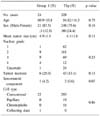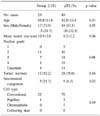Abstract
Purpose
As compared with pathologic stages T1 and T2, we aimed to investigate the difference of the prognosis for the patients with perirenal fat invasion (pT3a), and the patients were divided into two groups by the tumor size of 7cm.
Materials and Methods
Of the 503 patients who underwent an operation for renal cell carcinoma between June 1995 and April 2004, we retrospectively reviewed the records of 455 patients with T1, T2 and T3a stage renal cell carcinoma without adrenal invasion. We evaluated the cell type, the multifocality of the tumor, the nuclear grade, the presence of a sarcomatoid component and the coagulative histologic necrosis. We divided the patients with pT3a renal cell carcinoma into two groups according to the tumor size of 7cm (Group 1; ≤7cm pT3a, Group 2; >7cm pT3a). The overall survival was estimated using the Kaplan-Meier method and the log-rank test. We used Student's t-test to compare each factors between groups 1 and 2 and the T1 and T2 groups, respectively. The prognostic factors that had an influence on survival were estimated using the Cox proportional hazard regression model in each group.
Results
After the exclusion criteria (the presence of adrenal invasion in pT3a patients) were applied, 24 patients were in group 1, 23 patients were in group 2, 328 patients had pT1 disease and 80 patients had pT2 disease. The median follow-up was 45.4 months. When group 1 was compared to the pT1 group, there was no significantly difference of the estimated survival (p=0.21). There was a similar result when comparing the estimated survival between group 2 and the pT2 group (p=0.80).
Conclusions
No significant difference exists for the disease specific survival when patients with pT3a disease (Groups 1 and 2) are compared to the patients with either pT1 or pT2 disease. These findings reveal that patients with pT3a disease without adrenal invasion have similar outcomes to patients with either with pT1 or pT2 disease. Therefore, our result suggests that pT3a tumor should be re-classified according to tumor size into pT3a without adrenal invasion.
Figures and Tables
Fig. 1
Survival curves according to the same size category of 7cm or less renal cell carcinoma (p=0.21).

References
1. Kim WJ, Chung JI, Hong JH, Kim CS, Jung SI, Yoon DK. Epidemiologic study for urologic cancer in Korea (1998-2002). Korean J Urol. 2004. 45:1081–1088.
2. Guinan P, Sobin LH, Algaba F, Badellino F, Kameyama S, MacLennan G, et al. TNM staging of renal cell carcinoma: Workgroup No. 3. Union International Contre le Cancer (UICC) and the American Joint Committee on Cancer (AJCC). Cancer. 1997. 80:992–993.
3. Gettman MT, Blute ML. Update on pathologic staging of renal cell carcinoma. Urology. 2002. 60:209–217.
4. Gofrit ON, Shapiro A, Kovalski N, Landau EH, Shenfeld OZ, Pode D. Renal cell carcinoma: evaluation of the 1997 TNM system and recommendations for follow-up after surgery. Eur Urol. 2001. 39:669–674.
5. Tsui KH, Shvarts O, Smith RB, Figlin RA, deKernion JB, Belldegrun A. Prognostic indicators for renal cell carcinoma: a multivariate analysis of 643 patients using the revised 1997 TNM staging criteria. J Urol. 2000. 163:1090–1095.
6. Roberts WW, Bhayani SB, Allaf ME, Chan TY, Kavoussi LR, Jarrett TW. Pathological stage does not alter the prognosis for renal lesions determined to be stage T1 by computerized tomography. J Urol. 2005. 173:713–715.
7. Greene FL, Page DL, Fleming ID, Fritz A, Balch CM, Haller DG, et al. AJCC cancer staging manual. 2002. 6th ed. New York: Springer-Verlag;230–231.
8. Baek MK, Jeong IG, Jeong SJ, Jeong H, Kwak C, Lee ES, et al. The prognostic significance of ipsilateral adrenalectomy during radical nephrectomy for renal cell carcinoma. Korean J Urol. 2003. 44:833–837.
9. Robson CJ, Churchill BM, Anderson W. The results of radical nephrectomy for renal cell carcinoma. J Urol. 1969. 101:297–301.
10. Zisman A, Pantuck AJ, Dorey F, Said JW, Shvarts O, Quintana D, et al. Improved prognostication of renal cell carcinoma using an integrated staging system. J Clin Oncol. 2001. 19:1649–1657.
11. Frank I, Blute ML, Cheville JC, Lohse CM, Weaver AL, Zincke H. An outcome prediction model for patients with clear cell renal cell carcinoma treated with radical nephrectomy based on tumor stage, size, grade and necrosis: the SSIGN score. J Urol. 2002. 168:2395–2400.
12. Fergany AF, Hafez KS, Novick AC. Long-term results of nephron sparing surgery for localized renal cell carcinoma: 10-year followup. J Urol. 2000. 163:442–445.
13. Hafez KS, Fergany AF, Novick AC. Nephron sparing surgery for localized renal cell carcinoma: impact of tumor size on patient survival, tumor recurrence and TNM staging. J Urol. 1999. 162:1930–1933.
14. Siemer S, Lehmann J, Loch A, Becker F, Stein U, Schneider G, et al. Current TNM classification of renal cell carcinoma evaluated: revising stage T3a. J Urol. 2005. 173:33–37.
15. Ficarra V, Prayer-Galetti T, Novella G, Bratti E, Maffei N, Dal Bianco M, et al. Incidental detection beyond pathological factors as prognostic predictor of renal cell carcinoma. Eur Urol. 2003. 43:663–669.
16. Frank I, Blute ML, Cheville JC, Lohse CM, Weaver AL, Leibovich BC, et al. A multifactorial postoperative surveillance model for patients with surgically treated clear cell renal cell carcinoma. J Urol. 2003. 170:2225–2232.
17. Frank I, Blute ML, Cheville JC, Lohse CM, Weaver AL, Zincke H. Solid renal tumors: an analysis of pathological features related to tumor size. J Urol. 2003. 170:2217–2220.
18. Thomas DH, Verghese A, Kynaston HG, Griffiths DF. Analysis of the prognostic implications of different tumor margin types in renal cell carcinoma. Histopathology. 2003. 43:374–380.
19. Patard JJ, Leray E, Rodriguez A, Rioux-Leclercq N, Guille F, Lobel B. Correlation between symptom graduation, tumor characteristics and survival in renal cell carcinoma. Eur Urol. 2003. 44:226–232.
20. Cheon SY, Doo HW, Kim HJ, Lee DG. Influence of nuclear grade on prognosis in patients with renal cell carcinoma treated by radical nephrectomy. Korean J Urol. 2003. 44:838–843.




 PDF
PDF ePub
ePub Citation
Citation Print
Print






 XML Download
XML Download